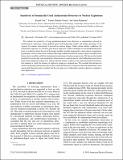| dc.contributor.author | Carr, Rachel | |
| dc.contributor.author | Dalnoki-Veress, Ferenc | |
| dc.contributor.author | Bernstein, Adam | |
| dc.date.accessioned | 2018-08-13T19:57:54Z | |
| dc.date.available | 2018-08-13T19:57:54Z | |
| dc.date.issued | 2018-08 | |
| dc.date.submitted | 2018-05 | |
| dc.identifier.issn | 2331-7019 | |
| dc.identifier.uri | http://hdl.handle.net/1721.1/117345 | |
| dc.description.abstract | We evaluate the sensitivity of large gadolinium-doped water detectors to antineutrinos released by nuclear-fission explosions, using updated signal and background models and taking advantage of the capacity for seismic observations to provide an analysis trigger. Under certain realistic conditions, the antineutrino signature of a 250-kton pure-fission explosion could be identified several hundred kilometers away, in a detector about the size of the largest module currently proposed for a basic physics experiment. In principle, such an observation could provide rapid confirmation that the seismic signal coincided with a fission event, possibly useful for international monitoring of nuclear-weapon tests. We discuss the limited potential for seismically cued antineutrino observations to constrain fission yield, differentiate pure fission from fusion-enhanced weapon tests, indicate that the seismic evidence of an explosion had been intentionally masked, or verify the absence of explosive testing in a targeted area. We conclude that advances in seismic monitoring and neutrino physics have made the detection of explosion-derived antineutrinos more conceivable than previously asserted, but the size and cost of sufficiently sensitive detectors continue to limit applications. | en_US |
| dc.publisher | American Physical Society | en_US |
| dc.relation.isversionof | http://dx.doi.org/10.1103/PhysRevApplied.10.024014 | en_US |
| dc.rights | Article is made available in accordance with the publisher's policy and may be subject to US copyright law. Please refer to the publisher's site for terms of use. | en_US |
| dc.source | American Physical Society | en_US |
| dc.title | Sensitivity of Seismically Cued Antineutrino Detectors to Nuclear Explosions | en_US |
| dc.type | Article | en_US |
| dc.identifier.citation | Carr, Rachel et al. "Sensitivity of Seismically Cued Antineutrino Detectors to Nuclear Explosions." Physical Review Applied 10, 2 (August 2018): 024014 © 2018 American Physical Society | en_US |
| dc.contributor.department | Massachusetts Institute of Technology. Laboratory for Nuclear Science | en_US |
| dc.contributor.mitauthor | Carr, Rachel | |
| dc.relation.journal | Physical Review Applied | en_US |
| dc.eprint.version | Final published version | en_US |
| dc.type.uri | http://purl.org/eprint/type/JournalArticle | en_US |
| eprint.status | http://purl.org/eprint/status/PeerReviewed | en_US |
| dc.date.updated | 2018-08-13T18:00:12Z | |
| dc.language.rfc3066 | en | |
| dc.rights.holder | American Physical Society | |
| dspace.orderedauthors | Carr, Rachel; Dalnoki-Veress, Ferenc; Bernstein, Adam | en_US |
| dspace.embargo.terms | N | en_US |
| mit.license | PUBLISHER_POLICY | en_US |
